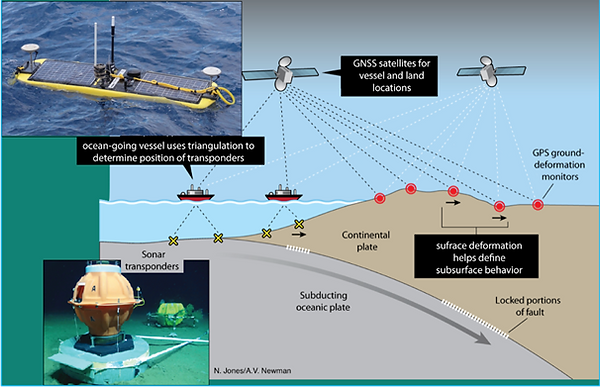NSF-funded Instrument Pool
Grown from a proposal to the Mid-scale Research and Infrastructure Program, in fall of 2019 the National Science Foundation funded the development of seafloor instrumentation to measure GNSS-Acoustic and pressure signals. The development team includes C. David Chadwell*, Mark Zumberge*, Noel Bartlow, Andrew Newman, David Schmidt, and Spahr Webb, with funds going to Scripps Institute of Oceanography (*home of project PIs). Funding for the initial pool supported the purchase and initial testing (commissioning) of instruments .

Instrumentation
GNSS-Acoustic instrumentation include 51 acoustic transponders with 10-year battery packs, and 48 cement seafloor benchmarks, built for precision repeat occupation. Instrumentation is sufficient for 16 triangulated transponder sites (+3 spare). Three (3) Wave Gliders will serve as the sea surface link between GNSS and the seafloor transponders.
Pressure gauges (17 in total) are to be incorporated within the transponder assemblies at the 16 potential sites (+1 spare). These too have 10-year battery life.

Generalized trans-subduction boundary instrument deployment
Simplified representation of a combined seafloor GNSS-A and on-land GNSS deployment in a subduction zone environment. Instrumentation insets include a [top left] Wave Glider configured with GNSS and solar power for communications (locomotion is driven by wave energy), and a [bottom left] seafloor transponder atop a reusable benchmark (pressure sensors are installed within transponder housing). Cartoon modified from Newman et al. (2011).
Updates:
Field Testing report -- Updated 1/29/2021: The equipment (51 Fetch transponders and three wave gliders with GNSS-A modules) from Liquid Robotics, Inc., and Sonardyne, was received in the latter half of 2020. Twelve of the Fetch units were recalled by Sonardyne to correct a manufacturing flaw detected at their factory in the UK. They have since been fixed and returned to Scripps.
All three wave gliders were deployed in late 2020 in two tests offshore San Diego (as basic wave gliders without GNSS-A modules installed). All performed well. In January of 2021, two of the wave gliders were tested with their GNSS-A modules offshore San Diego, ranging to a Fetch unit in shallow water (50 m). The data are currently being analyzed.
Seventeen (17) of the Fetch units are equipped with pressure sensors. Half of them have been lab calibrated with a piston gauge calibrator. As part of the pressure gauge calibration, the plumbing is checked for leaks. So far one leak has been discovered which remains to be corrected.
Deployment as part of a community experiment-- Updated 7/13/2023: Six of the twelve instruments slated for the Near-trench community experiment have been successfully deployed off of Cascadia. All stations are going through interrogation with a Wave Glider for positions. Read more here.

